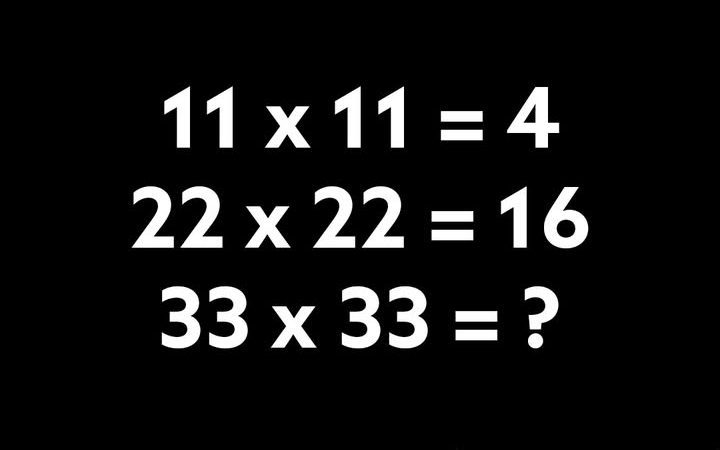Here’s a riddle that’s been making people scratch their heads and second-guess their logic. It looks like basic multiplication at first glance—but don’t be fooled. This puzzle comes with a hidden twist that catches most people off guard. In fact, only around 10% of people solve it correctly on the first try.
So, if you’re ready for a little brain workout, buckle up. This one will make you rethink everything you thought you knew about numbers.

The Puzzle That’s Trickier Than It Looks
Here it is:
11 × 11 = 4
22 × 22 = 16
33 × 33 = ?
You might be thinking, wait, that math doesn’t add up at all. And you’d be absolutely right—if you were following standard multiplication rules. But this isn’t your everyday equation. This riddle is a test of pattern recognition, not math class accuracy.
Let’s break it down step-by-step and reveal the clever twist behind the numbers.
Video: Treat your brain to a dose of fun with these light and playful puzzles!
Why This Puzzle Trips Up So Many People
First, let’s talk about why this riddle throws people off.
We Expect Traditional Math
Our brains are wired to see equations and immediately jump into solving them with logic we already know. So when we see “11 × 11,” we automatically think, “Oh, that’s 121.” But that mindset is what makes the trick work.
We Overthink or Underthink
People either go too far down the math rabbit hole or not far enough. It’s common to miss the sweet spot where the real pattern lives—right in plain sight.
It’s All About Pattern, Not Product

The trick isn’t in the multiplication—it’s in the digits themselves. This puzzle hides its logic behind simple addition and multiplication of the digits in the equation.
Let’s show you exactly how it works.
Solving the Puzzle Step-by-Step
Let’s revisit the equations, but this time with fresh eyes.
11 × 11 = 4
Look at the digits: 1 + 1 = 2
Now multiply that: 2 × 2 = 4
Boom! The answer has nothing to do with multiplying 11 by 11 in the traditional sense.
22 × 22 = 16
Add the digits: 2 + 2 = 4
Now: 4 × 4 = 16
Still with me? It’s simple math, but a clever shift in how you’re looking at the numbers.
So what about 33 × 33?
Let’s apply the same logic:
3 + 3 = 6
Then: 6 × 6 = 36
And there’s your answer. The final result is 36.

The Genius Behind the Trick
This puzzle plays a little psychological game with your mind. It sets the stage with familiar numbers and symbols, then subverts your expectations. You’re supposed to fall into the trap of thinking in straight equations. But when you pause and focus on the digits—not the numbers as wholes—that’s when the truth clicks into place.
It’s not meant to test your math skills. It’s designed to test your flexibility—how quickly you can shift gears and think outside the box.
How to Spot These Tricky Patterns in the Future
Want to get better at spotting these riddles before they fool you? Here’s what helps:
Pause Before You Solve
Take a breath before jumping to conclusions. Ask yourself: “Could there be a hidden pattern?”
Look for Digit-Based Logic
When something doesn’t add up, don’t panic—break it down to the digits. Sometimes, it’s not about the whole number but what it’s made of.
Train Your Pattern Recognition
Try more puzzles like this. The more you train your brain to find patterns, the better you’ll get at it.
Challenge Your Friends—It’s More Fun That Way
Video: Maths Puzzles With Answers
This kind of riddle is perfect to share. Ask your friends to solve it, and watch as they try to multiply their way into the wrong answer. Then enjoy that “aha!” moment together when they realize what’s going on.
It’s a fun way to turn casual conversation into a light mental workout.
The Real Lesson Here? Think Differently
At the end of the day, puzzles like this remind us that not everything is what it seems. Sometimes, solving a problem isn’t about having the right equation—it’s about asking the right question.
What looks like a math problem is actually a test of perception. And that’s what makes this riddle so clever—and so satisfying to solve.
Conclusion: It’s Not Just a Puzzle—It’s a Mindset Shift
So, did you get the answer before we gave it away? Whether you cracked it or got tricked, you just exercised one of the most valuable skills you have: creative thinking.
This simple-seeming equation taught us a powerful lesson—when something doesn’t make sense, maybe it’s because you’re looking at it the wrong way. That applies to more than just riddles, doesn’t it?
Next time you see a puzzle like this, slow down, zoom in on the details, and question your assumptions. You might surprise yourself with what you discover.
And remember—when it comes to clever challenges like this one, it’s not about being right the fastest. It’s about being curious enough to keep trying.
